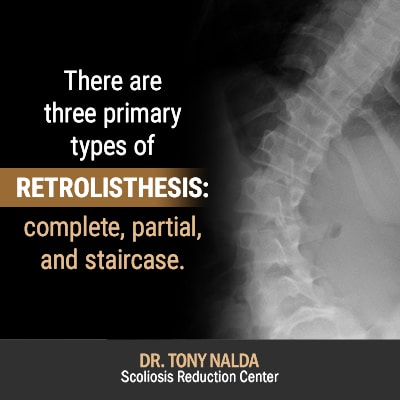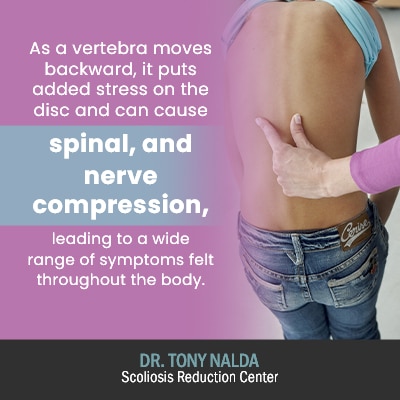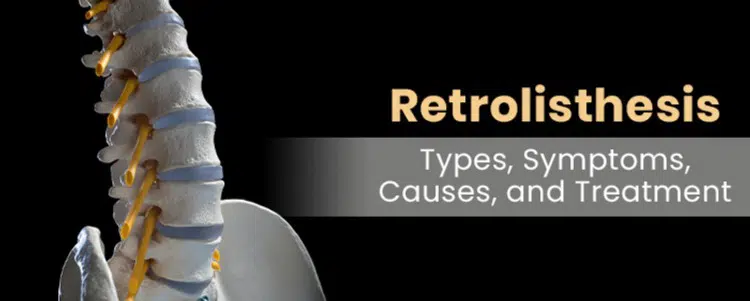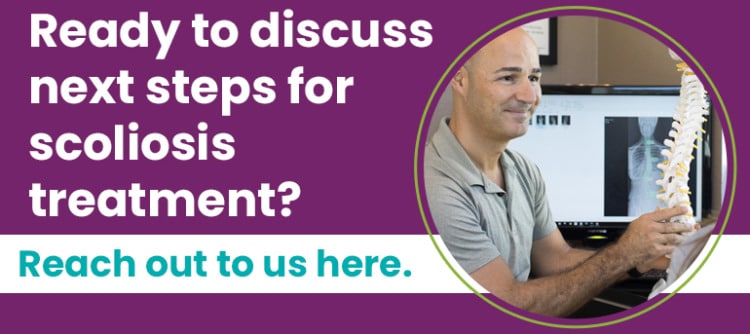The optimal function of the spine depends on the health of its individual parts. The spine consists of multiple bones called vertebrae, which are stacked on top of one another in a straight and neutral alignment, separated by intervertebral discs. Retrolisthesis involves a vertebra shifting backward out of alignment with the rest of the spine and can have multiple causes, types, and treatment needs.
Retrolisthesis is a spinal condition characterized by joint dysfunction that occurs when a single vertebra (spinal bone) shifts backward or underneath an intervertebral disc. Retrolisthesis develops in the cervical or lumbar spine. It can cause a range of symptoms and needs to be treated proactively.
Before discussing the specifics of retrolisthesis, let’s touch on some basic spinal anatomy to better understand how the condition affects the spine structurally.
Understanding the Spine
As mentioned, the spine is made up of individual bones called vertebrae that are rectangular in shape and stacked on top of one another.
If the vertebrae remain in a healthy and neutral alignment, the spine can maintain its natural and healthy curvatures to function optimally; however, if the spine becomes misaligned due to a vertebra shifting out of alignment with the rest of the spine, problems can occur.
The vertebrae are separated by the spine’s intervertebral discs that provide cushioning so they don’t rub up against each other and create friction, facilitate flexible movement, help absorb/distribute stress, and help hold the parts of the spine together.
So you can see the placement of the spine’s vertebrae is important, as is the health of its intervertebral discs.
There are three main sections of the spine: cervical (neck), thoracic (middle/upper back), and lumbar (lower back).
Now that we have a basic understanding of the spine’s structure, let’s look at how spinal conditions like retrolisthesis can affect the spine on a structural level.
What is Retrolisthesis?
There are a number of spinal conditions a person can develop that affect the structure, function, and overall health of the spine.
When a person develops retrolisthesis, this is an uncommon joint dysfunction involving a single vertebra shifting backward alongside or underneath a spinal disc.
The condition affects the cervical spine (neck and shoulder area) or the lumbar spine (lower back), and while it can occur in the thoracic spine, it’s uncommon.
The movement of a vertebra doesn’t have to be significant to impact the spine negatively; even vertebral movement as little as 2 millimeters can disrupt the spine’s alignment and biomechanics.
Retrolisthesis, a condition characterized by the displacement of one vertebra relative to the one below it, can vary in severity, with Grade 1 retrolisthesis being a milder form often measuring less than 4 mm. Commonly seen in the lumbosacral region, such as L4-L5 or L5-S1, Grade 1 retrolisthesis may cause symptoms like back pain and muscle stiffness.
Treatment options for Grade 1 retrolisthesis L5-S1 may include core exercises to strengthen abdominal and back muscles, helping to alleviate discomfort and improve spinal stability. Additionally, neck muscles and neck pain may indirectly contribute to retrolisthesis, underscoring the importance of comprehensive management and muscle strengthening exercises tailored to individual needs.
Retrolisthesis, a condition where a vertebra shifts backward in the spine, can sometimes be associated with S-shaped scoliosis, and understanding its types, symptoms, causes, and treatment is crucial for comprehensive spine care.
Retrolisthesis can vary in severity, and understanding whether a 3 mm retrolisthesis is bad requires careful evaluation of symptoms and causes; this condition, which can affect the cervical and thoracic spine, is often diagnosed through magnetic resonance imaging, revealing issues with facet joints and other spinal structures.
Retrolisthesis, defined as the posterior displacement of one vertebral body relative to the one below it, can vary in severity from 1mm to 5mm, with degenerative spondylolisthesis and disc degeneration being common underlying causes.
Retrolisthesis can occur at various levels, including the commonly affected C5-C6 segment. Whether a 5mm retrolisthesis is concerning depends on individual factors, with symptoms like chronic low back pain often prompting evaluation. Understanding the types, symptoms, causes, and treatment options for retrolisthesis, including degenerative spondylolisthesis, is crucial for effective management and addressing any associated discomfort.
Understanding the types, symptoms, and causes of retrolisthesis is crucial in determining appropriate treatment approaches for this condition, and while a 5 mm retrolisthesis may raise concerns, the severity and symptoms dictate the necessity of intervention.
Retrolisthesis, ranging from 5 mm retrolisthesis at different levels like C3-C4, L2-L3, and C4-C5, is a condition associated with lumbar disc herniation, degenerative disc disease, and other degenerative spinal disorders, often requiring assessment of severity and consideration of treatment options based on grading criteria.
Now, when it comes to spinal conditions, there are often different condition types, with different causation and treatment needs, and retrolisthesis is no exception.
Types of Retrolisthesis

There are three primary types of retrolisthesis: complete, partial, and staircase.
Complete retrolisthesis involves a single vertebra moving backward in relation to adjacent vertebrae (above and below).
Partial retrolisthesis involves a single vertebra moving backward, towards the vertebrae above it, or below it.
Staircase retrolisthesis occurs when a single vertebra moves backward, away from those above and ahead of those below.
These differences are subtle and can be hard to visualize. The condition involves a spinal vertebra shifting backward, out of alignment with the rest of the spine, affecting the spine’s structural integrity, and sometimes, the shift in position can involve a vertebra sliding backward and underneath an intervertebral disc.
So now that we know how the condition affects the spine’s structure and alignment let’s talk about causation.
What are the Causes of Retrolisthesis?
The spine of a person with retrolisthesis will have less space between the vertebrae, which can happen for different reasons.
While research has not come up with a clear definitive answer as to why the discs and space between the vertebrae decrease on their own, the following variables are thought to be contributing factors:
- Spinal-degeneration issues
- Arthritis
- Congenital abnormalities
- Spinal injury or trauma
- Blood/bone infections
- Nutritional deficiencies
- Spinal conditions like osteoporosis
- Weakened core and spinal muscles
What are the Symptoms of Retrolisthesis?
As is the case with most spinal conditions, retrolisthesis symptoms will vary from one person to the next and can range from mild to severe, but common symptoms include:
- General back pain
- Localized back pain
- A decreased range of motion
- Sharp pinching pain related to nerve compression
- A noticeable bulge in the spine
In more severe cases, symptoms can also be felt in areas other than the back, with some experiencing feelings of numbness and/or tingling in the following extremities:
- Shoulders
- Neck
- Arms
- Legs
- Thighs
- Hips
- Buttocks
Retrolisthesis can cause the size of the spinal canal (hollow space within each vertebra), through which the nerves pass, to narrow.

As a vertebra moves backward, it puts added stress on the disc and can cause spinal, and nerve compression, leading to a wide range of symptoms felt throughout the body.
Nerves are like branches on a tree, fanning off in multiple directions; if retrolisthesis has caused the narrowing of the spinal canal, the discs and spinal nerves can become compressed and irritated, and this can cause varying levels of back pain. This pain can be felt throughout the body along the paths of the spinal nerves too.
Understanding the severity of retrolisthesis, including its grades and impact on the vertebral body within the degenerative lumbar spine, is crucial for devising effective treatment strategies; this knowledge also informs patients on how to sleep with retrolisthesis, especially if the displacement measures 7mm, ensuring proper spinal alignment and support for the affected spinal segment.
So if you are experiencing any of the symptoms mentioned above and have received a retrolisthesis diagnosis, you might be wondering how serious it is.
Additional reading: What Is Spondylosis? Types of Spondylosis & Treatment
How Serious is Retrolisthesis?
As is also the case with many spinal conditions, early detection can’t guarantee treatment success but can increase its chances.
If a diagnosis is given early, the slippage of the spinal vertebra can be stabilized, but if left untreated, it can worsen over time and lead to related complications.
Particularly in adults over the age of 50, who can be prone to spinal degeneration related to aging, if left untreated, retrolisthesis can lead to cervical spondylotic myelopathy (CSM).
As spinal/nerve compression increases, it can lead to increased neck and back pain, numbness, tingling, and/or weakness in the extremities (arms and legs), issues with coordination and balance, and reduced mobility.
Regardless of age or condition type/severity, being proactive and seeking out treatment is always the right choice. Spinal conditions like retrolisthesis don’t simply resolve on their own; they need to be assessed and treated proactively and effectively.
So is retrolisthesis serious? It can be, particularly for older adults who can also have age-related spinal degeneration to deal with. If left untreated, it can lead to the development of other spinal conditions and symptoms that can increase as the condition worsens.
As I’ve mentioned, proactive treatment is key, which leads us to the next topic of retrolisthesis treatment options.
Retrolisthesis Treatment Options
There are a number of different treatment options for retrolisthesis. The design of effective treatment plans addresses important patient/condition characteristics for a customized approach.
Factors such as patient age, causation, condition severity, and how the area around the slippage is impacted will be the guiding force of treatment.
Here at the Scoliosis Reduction Center®, I have experience treating a wide range of spinal conditions, retrolisthesis included, and one of the goals of my conservative chiropractic-centered approach is to effectively treat spinal conditions nonsurgically.
While no treatment results can ever be guaranteed, combining different treatment disciplines and methods offer the best possible results.
Physical therapy can be effective at increasing strength in the back and the core muscles, so the spine is better supported and stabilized.
Targeted condition-specific exercises can activate certain areas of the brain for a better brain-body connection and increase overall strength and spinal support.
When it comes to chiropractic care, this can involve gentle and precise adjustments through techniques such as flexion-distraction therapy that works towards stretching and decompressing the spine.
Through the use of a traction table, negative pressure and space can be created within the affected disc, and this can work by allowing the disc fluid to move back to where it should be, which means the disc has a better nutrient supply and is better able to heal itself.
Alternative treatments like massages and heat therapy can also be effective at improving circulation and easing discomfort. Microcurrent therapy can also be used to reduce swelling, inflammation, and pain.
Retrolisthesis, a condition where one vertebra slips backward on another, can cause a range of symptoms including back pain and discomfort, especially in individuals with levoconvex scoliosis, levoconvex lumbar scoliosis, multilevel degenerative disc disease, or multilevel spondylosis.
Understanding the types, causes, and treatment options for retrolisthesis is essential for managing this condition, especially for those who also have to consider how to sleep with scoliosis.
Retrolisthesis, characterized by the backward displacement of a vertebra relative to the one below it, can lead to various symptoms, causes, and types of this condition. In some cases, retrolisthesis may also be associated with the reversal of cervical lordosis, which can impact the cervical spine’s curvature and alignment.
Conclusion
Retrolisthesis is a spinal condition involving the degeneration of the spine’s intervertebral discs, caused by a vertebra’s backward slippage putting uneven pressure on the disc and its surrounding area.
This loss of disc space can lead to the narrowing of the spinal canal, which can interfere with nerve transmission of messages from the brain and cause nerve compression and the related symptoms of pain and a reduced range of motion in the spine.
Depending on the severity of the condition, and its causation, symptoms of retrolisthesis can include neck and shoulder pain, back pain, tingling and numbness caused by nerve compression, a stiff and weak spine, and a noticeable bulge in the spine.
Retrolisthesis is not a common spinal condition. Like other more-prevalent conditions, it needs to be treated proactively and effectively to prevent the condition from worsening and causing severe symptoms to develop.
Through a combination of precise and gentle chiropractic adjustments, physical therapy, and custom-prescribed condition-specific exercises, the health of the spine’s intervertebral discs can be improved, along with the spine’s strength, support, and core muscle strength.
Here at the Scoliosis Reduction Center®, I work closely with each patient to craft customized treatment plans that offer the best potential results without invasive and costly surgery.





